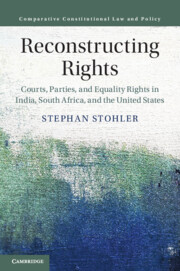 Reconstructing Rights
Reconstructing Rights Book contents
5 - Equality Rights in Indian Employment
from Part III - India
Published online by Cambridge University Press: 09 July 2019
Summary
The Indian National Congress had opposed reservations (affirmative action) for India's so-called "Other Backward Classes" (OBCs) since drafting India's Constitution. But when a coalition government expanded reservations for OBCs in public employment in 1990, Congress changed its position, potentially bringing the party into conflict with the judges it had previously appointed. But this conflict never occurred. Instead, Congress officials subsequently worked with aligned justices to develop a new doctrinal framework governing reservations in employment. When these justices adopted divergent positions, however, Congress frequently overruled them with constitutional amendments. Unlike the American case, however, India's Supreme Court subsequently reviewed these amendments under the basic structure doctrine, affording them the opportunity to exercise a final say. But, in each instance, these aligned justices capitulated while nonetheless preserving a voice in important constitutional deliberations, which is consistent with the book's argument.
Keywords
- Type
- Chapter
- Information
- Reconstructing RightsCourts, Parties, and Equality Rights in India, South Africa, and the United States, pp. 133 - 165Publisher: Cambridge University PressPrint publication year: 2019
